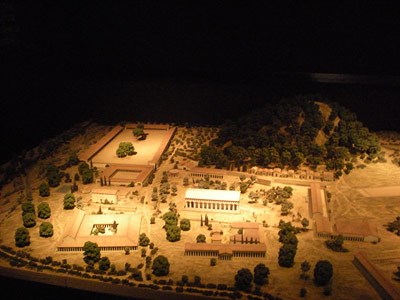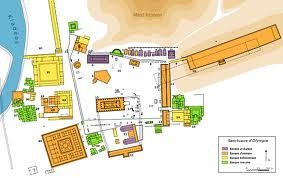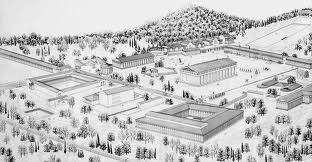The Tsunami which destroyed Ancient Olympia

Vibracores were drilled in the environs of ancient Olympia, and between Olympia and the present coastline in order to detect the local sedimentary record. The photo shows a coring site on the western terrace of the Kladeos River, just a few hundred meters to the west of the Temple of Zeus. In the background the Kronos hill can be seen, Olympia's famous local mountain.
It appears now that Olympia, the site of the Temple of Zeus and of the ancient Olympic Games, was destroyed by several tsunamis reaching far inside the land and not, as had been generally accepted, through earthquakes and riverfloods. These insights results from the investigation of the almost eight-meter thick layers of sediments under which the ancient site lies buried.
Olympia, which is situated in the Northwest of the Peloponesian peninsula, was in antiquity a sanctuary of Zeus and the site of the Olympic Games. The remains of the once numerous buildings of this major ancient place of worship were rediscovered only 250 years ago, and the first digs were undertaken only in 1874. For a long time, it was believed that an earthquake had destroyed the sanctuaries in 551 A.D. and that subsequent floodings of the river Kladeos had buried the ancient constructions. It remained a mystery, though, how the modest creek Kladeos, which runs along the site, could have accumulated sediments several meters thick, and then have cut itself down through them by 10 to 12 meters, to find back to its ancient course.
A catastrophic accumulation of sediments
A team of scientists under the direction of Andreas Vött of the Geographic Institute of the Johannes Gutenberg University in Mainz has now investigated this area anew, together with the local Ephorate of the antiquities and colleagues from the Universities of Aachen, Darmstadt, Freiburg, Hamburg and Cologne, using geomorphological and geoarchaeological methods. It started from the hypothesis that one of the tsunamis which during the past 11,000 years have demonstrably visited the coasts of the oriental Mediterranean might have buried the ancient site.
"Both the composition and thickness of the sediments we find in Olympia do not go with the hydraulic potential of the Kladeos River and the geomorphological inventory of the valley. It is highly unlikely that this could have been the work of this creek," states Vött.
The results of the investigation indicate that Olympia was repeatedly hit by catastrophic floods during its history resulting in the site being buried under huge masses of sediment. The presence of mollusc and gastropod shells and the remains of abundant micro-organisms such as foraminifera are clear evidence of a marine origin of the sediment. The sediments were obviously transported inland at high velocity and high energy, reaching Olympia although the site lies some 33 meters above sea level. The most probable explanation is that tsunami waters overflowed the narrow range of hills between Olympia and the sea through low-lying saddles.
"In earlier times, Olympia was not 22 kilometers away from the sea as it is today. Back then, the coastline was located eight or perhaps even more kilometers further inland," explains Vött. In his scenario, tsunamis came in from the sea and rushed into the narrow Alpheios River valley, into which the Kladeos River flows, forcing their way over the saddles behind which Olympia is located. The cult site was thus flooded. Vött assumes that the flooding decreased only slowly because the outflow of the Kladeos through the Alpheios valley was blocked by incoming tsunami waters and corresponding deposits. The analysis of the various layers of sediments in the Olympia area suggests that this scenario came true on several occasions during the last 7,000 years. It was during one of the more recent of these events in the 6th century AD that Olympia was finally destroyed and buried.
The Olympia tsunami hypothesis is further supported by the fact that high-energy sediments of undoubtedly tsunamigenic origin were found on the seaward side of the hill range and these deposits are identical to those in Olympia itself. Vött points out that "the sediments around Olmypia have the same signature as the tsunamite in the lower Alpheios valley." Vött says that the cause of Olympia's destruction could not have been an earthquake because in this case the fallen fragments of the columns of the Temple of Zeus would directly lie on top of each other, but in fact they are "floating" in sediment. All the sedimentological, geochemical, geomorphological, and geoarchaeological findings obtained by the study support the new and sensational hypothesis that Olympia was destroyed by tsunamis. Detailed analyses of associations, origin, and age of microfauna as well as geochronological studies are currently in progress. Results are expected soon.
Tsunamis are well known from the eastern Mediterranean and are mainly the result of extensive seismic activities along the Hellenic Arc. Here, the African plate is being subducted by the Eurasian plate, repeatedly triggering major earthquakes that are followed by tsunamis. The most recent mega-tsunami in the Mediterranean occurred in 1908 related to an earthquake in the Straits of Messina in southern Italy, devastating the neighboring coastal region, more than 100,000 people were killed. A 30 meter-high tsunami wave was recorded in the southern Aegean in 1956. "The evaluation of historical accounts has shown that in western Greece there is one tsunami every eight to eleven years on average," specifies Vött.
(from a press release by the University of Mainz, Germany)
See also the full paper in pdf delivered at the Corinth Conference on the Olympia Tsunami
Andreas Vött

Professor Dr. Andreas Vött is specialized in paleotsunami and geoarchaeological research in the Mediterranean. Before coming to Johannes Gutenberg University Mainz in October 2010, Vött was professor of Physical Geography with a focus on Quaternary Research and Geoarchaeology at the Institute for Geography at the University of Cologne. As professor of Physical Geography/Geomorphology at Mainz University, Vött also heads the Natural Hazard Research and Geoarchaeology teaching and research section. His research also comprises aspects of coastal geomorphology such as sea level fluctuations during the Holocene, but also the spatial effects of human-environment interactions over the past millennia. Vött's work is coordinated with that of the JGU Research Center Geocycles and the Cluster of Excellence "Earth and the Anthropocene" (ERA), which has been invited to submit a full proposal for funding in the second phase of the German Excellence Initiative.
In September 2011, Andreas Vött presented the Olympia tsunami hypothesis at an international academic conference in Corinth in Greece.
See also:

A model of the ancient site of Olympia



